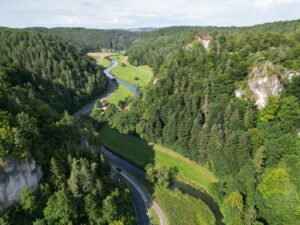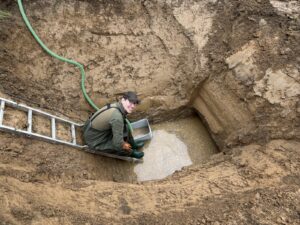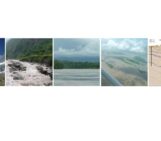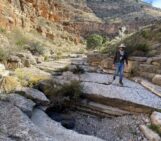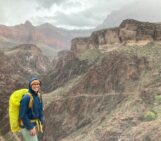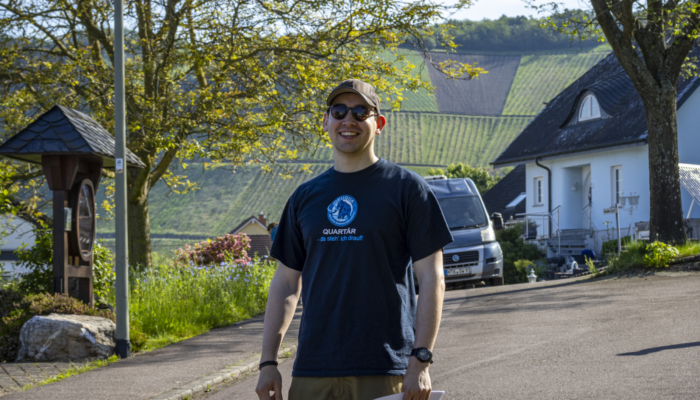
This blog post is a throwback to last year’s theme, “A Day in the Life of a Geomorphologist!” Please contact one of the GM blog editors, Emily (eb2043@cam.ac.uk) or Emma (elodes@asu.edu), if you’d like to contribute on this topic or others.
by Bastian Grimm, Doctoral Student, Giessen University, Germany
Email: bastian.grimm@geogr.uni-giessen.de
Hi, I’m Basti! I’m currently pursuing my PhD at Giessen University in Giessen (Germany), which is about 50 km north of Frankfurt, for those who may not be familiar with the area. While you might think I spend most of my days in my office or in university libraries, the reality is quite the opposite. I’m what you would call a “field guy,” and since my research area is right here in Germany, you can often find me out in the stunning landscapes of the Wiesent River catchment in the Northern Franconian Alb, Bavaria.
My research in this region focuses on the dynamic interaction between humans and fluvial environments, particularly in floodplain areas. As geomorphologists, we’re acutely aware of how natural fluvial systems evolve over geological time spans. Unfortunately, today, many of these natural systems have been significantly altered by anthropogenic activities. In Central Europe, we’ve observed a marked transition from natural to human-dominated floodplain systems. As my PhD project is part of the DFG-funded (German Research Foundation) special priority program 2361, titled “On the Way to the Fluvial Anthroposphere”, I’m particularly interested in how these landscapes have transformed over time and the impact of human activities on riverine sedimentary systems. Additionally, paleoenvironmental proxies will facilitate the attribution of environmental changes in floodplains to human and/or natural influences. My methodology is therefore multifaceted: I utilize digital elevation model (DEM) analyses, percussion drilling, trenching, and sedimentological, paleoecological, and stratigraphical analyses, along with luminescence dating to investigate the (chrono)stratigraphical evolution of floodplains. This often means a lot of “mud work,” but it’s a labor of love, allowing me to immerse myself in the fantastic world of nature.
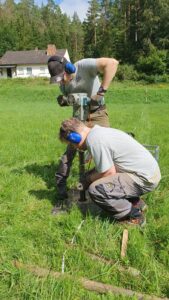
Drilling the floodplain to gain insights into the sedimentary floodplain architecture together with my student assistant. PC: Niklas Pauly.
Despite my frequent field trips, I also spend considerable time in the office. A typical day for me starts early in the morning. My alarm goes off, and before I know it, I’m up in the office and enjoying my first cup of coffee. I find the early hours to be serene; there’s something oddly comforting about the stillness of a dark lab at dawn. But why a dark lab and what do I do there? Actually, I’m diving into luminescence dating, a method that helps us ascertain the timing of sediment deposition by measuring the last time sediment was exposed to light. This helps me uncover the sediment dynamics I need to understand the human impact on the landscape.
After immersing myself in lab work, I devote time to reading the latest research papers on fluvial geomorphology and luminescence dating. It’s fascinating to observe how rapidly our field is evolving. Each new paper offers unique perspectives that might influence my own research. Being part of the SPP allows me to exchange ideas and insights with fellow geomorphologists, which is invaluable for my development.
At precisely 12:00 pm, I become a bit of a pied piper and gather my colleagues together for our lunchtime! For us, lunch is not just about food; it symbolizes a critical time for networking and discussing ideas. Sharing insights and experiences during these meals often proves just as nourishing as the food itself, allowing us to tackle challenges collaboratively.
The post-lunch hours require refocusing. Often, I transition to hands-on lab work or organizing logistics for upcoming field campaigns. Today, I’m preparing for an upcoming meeting, an exhilarating process that hones my ability to present my research clearly and confidently. These meetings are wonderful opportunities to reconnect with colleagues who have become friends while exploring amazing landscapes during field trips – sometimes, it feels like we’re reliving school trips!
On particularly good days, I might enjoy a second or even third cup of coffee with my colleagues and friends “down under” on the first floor. I consider these coffee breaks essential for my mental well-being; they nurture camaraderie while allowing us to discuss science from various perspectives.
I often find myself working into the evening, as the life of a researcher rarely adheres strictly to a 9-to-5 schedule. As the sun sets, I engage with various communities, including the “German Young Geomorphologists” where I serve as a representative on the board of the German Society for Geomorphology (DGGM). Participating in discussions about the challenges faced by early-career researchers is rewarding, but often also challenging. I also engage in the community commission of Geomorphica, a diamond open-access journal in geomorphology that champions the idea that science should be freely accessible to everyone. In my opinion, knowledge should not be confined to those with resources but available to all who seek it.
As the day winds down, I take a moment to reflect on my accomplishments. Each day as a PhD student brings its own challenges and victories, shaping my growth as a geomorphologist. Though it’s easy to become overly absorbed in research, I treasure the moments of connection, learning, and joy that accompany this journey.
Who knows what tomorrow will bring? One thing is certain: whether I find myself in the lab, out in the field, or sharing a laugh over coffee with colleagues, I am excited about the path ahead in the captivating world of geomorphology.
Here’s to the beauty of landscapes, the thrill of research, and the joy of collaboration. Until next time!

